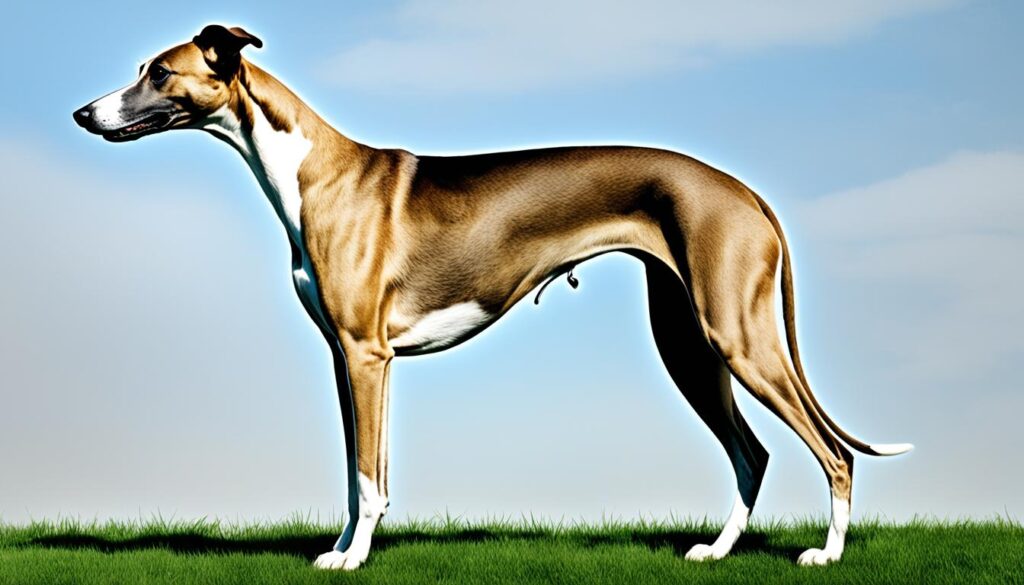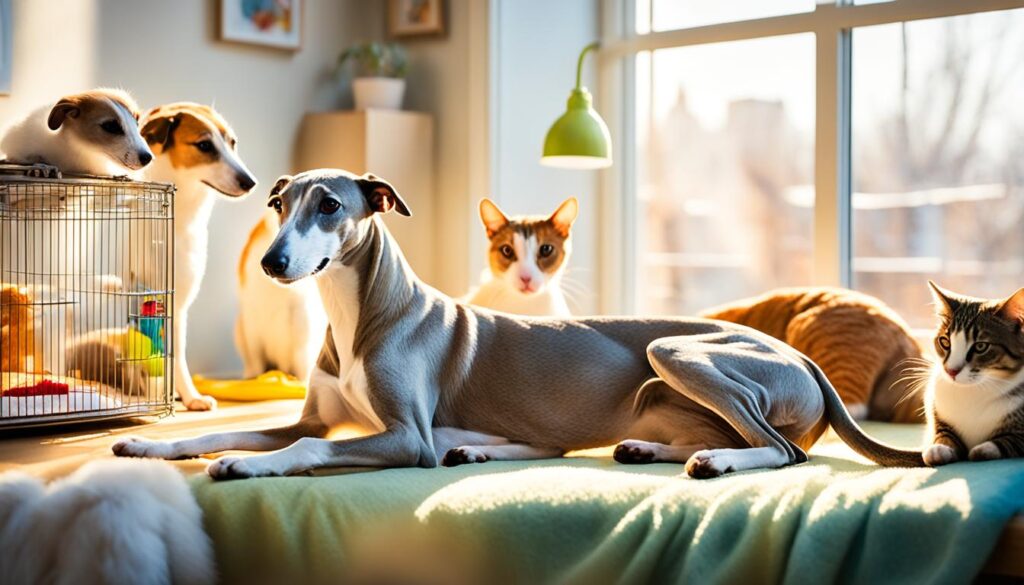Greyhounds begin racing at 18 months and retire at 3 to 4 years old. They are known for their speed. Yet, there’s much more to these dogs than just racing.
In this guide, we’ll cover everything about Greyhounds. From their history to their needs and how to care for them. Whether you’re thinking about adopting or just curious, this guide is for you.
Key Takeaways:
- Greyhounds typically start their racing careers at 18 months old and retire between the ages of 3 and 4.
- Greyhounds are elegant and agile dogs known for their speed and athleticism.
- This guide will provide comprehensive information on Greyhound history, temperament, care, and training.
- Whether you are considering adopting a retired Greyhound or want to learn more about the breed, this guide has you covered.
- Stay tuned to discover the joys of sharing your life with a Greyhound.
The Transition from Track to Home
Getting a retired racing Greyhound means understanding their past and what they need now. These fast dogs have mainly lived in a crate with little access to the outside. Getting them ready for a new loving home is very important. They need a gentle take-off from the track life and a lot of attention and care.
It takes time for Greyhounds to get used to their new life. They are used to racing, not living in a house. Introduce them slowly to your home. This helps them get used to new things and learn to trust.
Have a special spot in your home for your Greyhound. This should be a quiet place with a comfy bed or an open crate. They will feel safe there and this will help them adjust.
Greyhounds are used to living in a small space. So, freedom should be given little by little. Let them out of the crate for short times first. Watch them closely. As they learn, you can let them out longer.
New sounds can scare Greyhounds. Introduce them to these sounds slowly. This will make their new home less scary.
Your new Greyhound needs your love and attention. Spend time playing with them and taking them for walks. This helps them use their energy in a good way.
Every Greyhound is different. Understand your dog’s needs. If you face any trouble, look for help from people who understand Greyhounds well.
Greyhound Adoption: A Win-Win
Taking in a retired racing Greyhound is a win for both. These big hearted dogs need a home to relax and be loved in. Your care and understanding gives them a new shot at a great life.
| Vibrant Transition Tips: | Benefits for Your Greyhound: |
|---|---|
|
|
Greyhound Care Tips
Caring for your greyhound involves a few key points. These dogs are best indoors in a peaceful setting. Here’s what you need to know to take care of your greyhound:
1. Exercise:
Greyhounds have great athletic skills but need less exercise. Their slim bodies and short fur mean they’re sensitive to extreme weather. Be cautious in hot weather and keep them warm in winter.
2. Leash and Collar:
Keeping your greyhound on a leash is vital outdoors. They have a strong urge to chase small animals. A martingale collar is a good choice to keep them safe.
3. House Training:
Greyhounds learn to be clean quickly due to their past as racers. But, they might need help with stairs and adjusting to home life. Be patient and give them regular chances to go outside.
4. Health Care:
Regular vet visits are very important for your greyhound. They face risks like bloat and tooth issues. Stay current on their shots and protect them from parasites.
5. Mental Stimulation:
Even though greyhounds are calm, they need mental challenges. Offer them puzzle toys and games to keep sharp and avoid being bored.
These tips will help your greyhound be a happy and healthy part of your family.
Helpful Resources for Greyhound Owners

As a greyhound owner, staying informed and learning about your breed is key to great care. Thankfully, there are many resources out there to help.
Websites and Forums
The internet is a top resource for greyhound owners. You’ll find websites and forums full of greyhound info, advice, and support. They let you connect with others, share stories, and get advice.
Books on Greyhounds
There are also books that dive deep into greyhounds and what they need. These books give insights into behavior, training, health, and how to care for them. They’re great for all greyhound owners, whether you’re just starting or have had greyhounds for a while.
Local Greyhound Clubs
Joining a local greyhound club can offer more support and resources. These clubs put together meetups, events, and seminars. This is a good way to meet other enthusiasts and gain knowledge. They often share recommendations for local services too.
Greyhound Adoption Agencies
Adoption agencies are excellent if you’re considering adopting a retired racer. They help these dogs find loving homes and support adopters. They offer useful advice and guidance throughout the adoption process.
Greyhound Breeders
If you’re thinking about a breeder, choose wisely. Make sure they care about their dogs’ health. A good breeder can share important info on the breed and care tips.
Greyhound Associations
Greyhound associations, like the American Greyhound Council, are also helpful. They support greyhound health and offer educational materials. They’re another great resource for greyhound owners.
Greyhound and Other Pets

Thinking about getting a Greyhound? Understand their behavior with other pets. Greyhounds usually get along with dogs and cats. But, it might vary.
It’s key to check if a Greyhound is okay with cats if you have them. Start by slowly introducing your Greyhound to a cat. Watch how they act closely. This shows if they can live with cats or small pets.
Start dog introductions with careful, supervised meetings. This helps the dogs get to know each other safely. Look for any signs of aggression or being uncomfortable.
Always supervise after the first meeting. This is vital for a happy home with your Greyhound and other pets. A positive, safe space helps them all get along well.
Greyhound Housebreaking and Training
Training your Greyhound is a unique process. They are smart and eager to please, which makes it easier. Their crate training background might help with housebreaking. Yet, they could need time to fit into your daily routine.
When housebreaking, it’s crucial to be patient yet consistent. Stick to a routine with regular bathroom breaks. Take your dog out often, especially after eating, sleeping, or playing. Reward them with praise or treats to reinforce good habits. And always say no to training that scares or harms them.
Greyhounds, being sighthounds, love to run and chase. It’s vital they learn to walk on a leash safely. A martingale collar is a good choice. Always celebrate good actions with rewards and kind words during walks.
Remember, Greyhounds are bred to spot and chase fast-moving objects. So, keep them leashed outside an enclosed area. This way, they stay safe and under control.
Greyhound Housebreaking and Training Tips:
- Establish a consistent potty routine.
- Use positive rewards for good behavior.
- Be patient as your Greyhound learns their new home.
- For walks, use a well-fitting martingale collar and leash.
- Keep them on a leash to prevent chasing.
These tips can help your Greyhound adapt smoothly to your home. Always remember, staying consistent and being loving and positive is key during training.
| Pros | Cons |
|---|---|
| Greyhounds are intelligent and willing to please | They may require an adjustment period to your schedule |
| Previous crate training helps with housebreaking | They have a strong prey drive and should be kept on a leash during outdoor activities |
| Positive reinforcement training methods work well with Greyhounds | Off-leash exercise should be avoided unless in a secure, fenced area |
The History of the Greyhound Breed
The greyhound’s history goes back thousands of years. Ancient Egyptian art shows dogs very similar to greyhounds. These dogs are known for their beauty and grace, serving as hunters and later in races.
Ancient civilizations like the Egyptians admired the greyhound’s speed. They were seen as important figures, often by the side of pharaohs. During the Roman Empire, they became even more valuable.
In Roman times, greyhounds were used in games and hunting. Their ability to chase down game was highly respected. They were symbols of wealth and nobility.
In medieval Europe, greyhounds were associated with the upper class’s elegance. They were shown in paintings and tapestries as cherished pets of kings and nobles. This increased their status.
Today, greyhounds are still loved for their grace and beauty. They also face concerns in the racing industry.
The Greyhound Breed’s Key Characteristics
| Attribute | Description |
|---|---|
| Speed and Agility | Greyhounds are known for running up to 45 miles per hour. They are built for speed with their slim bodies and long legs. |
| Gentle Nature | Despite their speed, greyhounds are gentle. They are often called “gentle giants” and thrive in loving homes. |
| Elegance and Grace | Greyhounds are elegant and their movement is graceful. They truly stand out. |
| Minimal Grooming Needs | Greyhounds’ short coats mean they need little grooming. They only need occasional baths to stay looking good. |
| Unique Physiology | Their deep chest and lean body give greyhounds their speed and endurance. Their physique is designed for running. |
The greyhound’s long history and unique qualities make it a fascinating pet. Their speed, gentle nature, and beauty attract many people.
Physical Characteristics of Italian Greyhounds
Italian Greyhounds are a small, elegant breed with unique looks. They’re slender with a deep chest and long legs, giving them a graceful look. You can find them in many colors, like black, blue, and cream.
Their eyes are very expressive, and they always look alert. These dogs are very fast and love to chase things. They are known for their excellent eyesight and prey drive.
Conclusion
Greyhounds are amazing dogs with a calm and loving personality. They are unique because of their history and special qualities. They started as racing stars and now are adored as family pets, needing special care in both roles.
It’s essential to know what greyhounds need to be happy and healthy. They need a safe home and specific healthcare. Taking care of greyhounds means being dedicated and informed.
Owning a greyhound means learning about their breed. With the right care and love, they will flourish. Greyhounds bring loyalty and elegance, making them great family friends for those ready to give them a home.
FAQ
What is a greyhound?
How old do greyhounds start racing?
At what age do greyhounds retire from racing?
Can I adopt a retired racing greyhound?
How do I transition a retired greyhound from the track to a home?
How much exercise do greyhounds need?
Should greyhounds be on a leash?
Are greyhounds easy to house train?
How should I introduce my greyhound to other dogs and cats?
Can greyhounds be off-leash?
What is the history of the greyhound breed?
What are Italian Greyhounds?
How can I find more information about greyhounds?
Are greyhounds good with other pets?
Are greyhounds easy to train?
References
| American Kennel Club (AKC) | https://www.akc.org/dog-breeds/american-foxhound/ |
| United Kennel Club (UKC) | https://www.ukcdogs.com/american-foxhound |
| Canadian Kennel Club (CKC) | https://www.ckc.ca/en |
| Fédération Cynologique Internationale (FCI) | https://www.fci.be/ |








[…] home. These dogs can live in any space with the right love and care. If you’re looking for a gentle giant to join your family, the Irish Wolfhound may be just what you […]